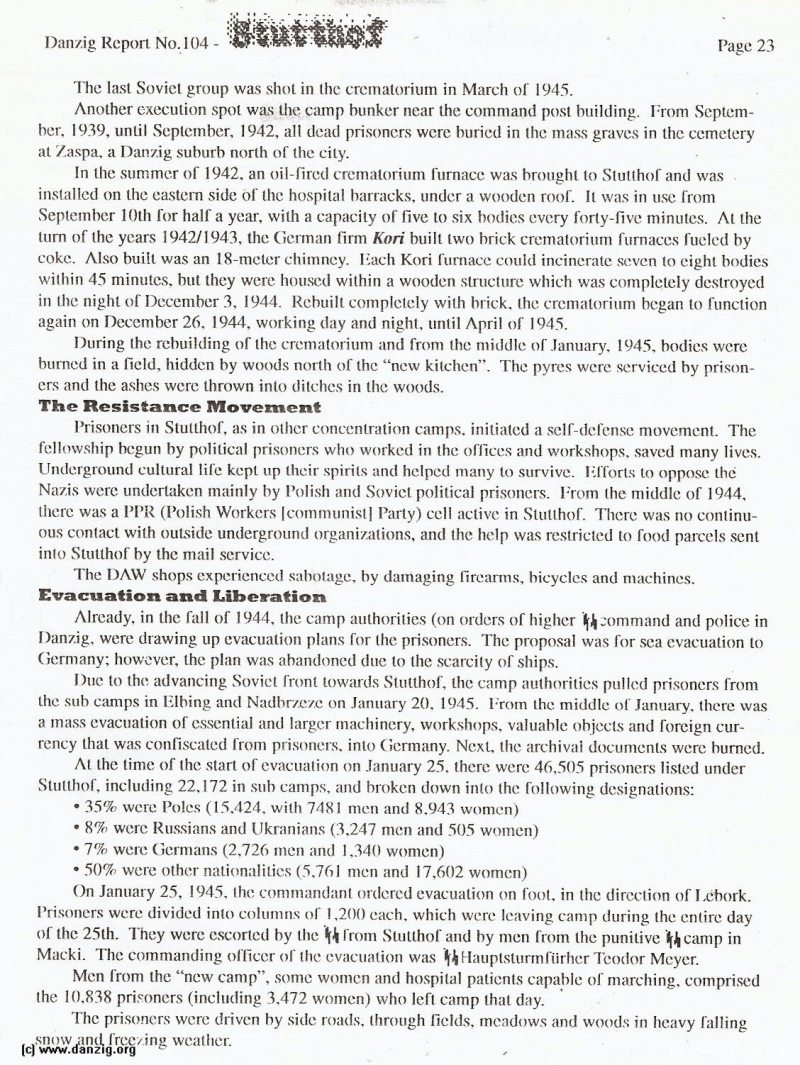
The last Soviet group was shot in the crematorium in March 011945.
Another execution spot was the camp hunker near the command post building. [rom Septemb er. 1939, until September. 1942. aH dead prisoners were buried in the mass graves in the cemetery at Zaspa. a Danzig suburb north of the city.
In the summer of 1942. an oil—lirc(l crematorium furnace was broughi to Stutthof and was installed on the eastern side of the hospital barracks, under a wooden roof. It was in usc from September 10th for half a year, with a capacity of five to six bodies every forty-five minutes. At the turn of the years 1942/1943, the (lerman firm Kori built two brick crematorium furnaces lueled by coke. Also built was an 18-meter chimney. lach Kori furnace could incinerate seven to eight bodies within 45 minutes. but they were housed within a wooden structure which was completely destroyed in the night of l)ecemher 3, l944. Rebuilt completely with brick, the crematorium began to function again Ofl December 26. 1944. working (lay and night, until April of 1945.
During the rebuilding of the crematorium and froni the middle of .Tanuary. 1945. bodies were burned in a field, hidden by woods north of (he “new kitchen”. The pyres were serviced by prisone rs and the ashes were thrown into ditches in the woods.
The Resistance Movement
Prisoners in Stutthof, as in other concentration camps. initiated a self—delense movement. The fellowship begun by political prisoners who worked in the olhces and workshops. saved many lives. Underground cultural life kept up their spirits and helped many to survive. Efforts to oppose the Nazis were undertaken mainly by Polish and Soviet political prisoners. [mm the middle of 1944, there was a PPR (Polish Workers communist I l’arty) cell active in Stutthoi. There was no continuo us contact with outside underground organizations, and the help was restricted to food parcels sent into Stuithof by the mail service. The DAW shops experienced sabotage. by damaging firearms, bicycles and machines.
Evacuation and Liberation
Already. in the fall of 1944, the camp authorities (on orders of higher k.ommand and police in l)anzig. were drawing up evacuation plans for the prisoners. The proposal was for sea evacuation to Germany: however, the plan was abandoned (Inc to the scarcity of ships.
Due to the advancing Soviet front towards Stutihof, the camp authorities pulled prisoners from the sub camps in Elbing and Nadbrieze on January 20. 1945. lrom the middle of January. (here was a mass evacuation of essential and larger machinery, workshops. valuable objects and foreign curr ency that was confiscated from prisoners, into Germany. Next, the archival documents were burned.
At the time of the start of evacuation on January 25. there were 46.505 prisoners listed tinder Stutthol, including 22.172 in sub camps. and broken down into the following designations:
• 35% were Poles (15,424. with 7481 men and 8.943 women)
• 8% were Russians and (lkranians (3,247 men and 505 women)
• 7% were (iermans (2,726 men and 1 .340 women)
• 50% were other nationalities (5,761 men and 17.602 women)
On January 25, 1945. the commandant ordered evacuation on loot, in the direction of I ehork. Prisoners were divided into columns of I .20(1 each, which were leaving camp during the entire day of the 25th. They were escorted by the 4 from Stutthof and by men from (lie punitive camp in Macki. The commanding oHicer of the evacuation was flauptsturmnfiirher Teodor Meyer.
Men from the “new camp”, some women and hospital patients capable of marching, comprised the 10.838 prisoners (including 3.472 women) who left camp that day.
The prisoners were driven by side roads, through fields. meadows and woods in heavy Iilling SflOW and frecing weather.
Danzig Report Vol. 1 - Nr. 104 - July - August - September - 1999, Page 24.
Hits: 3391
Added: 25/07/2015
Copyright: 2025 Danzig.org

